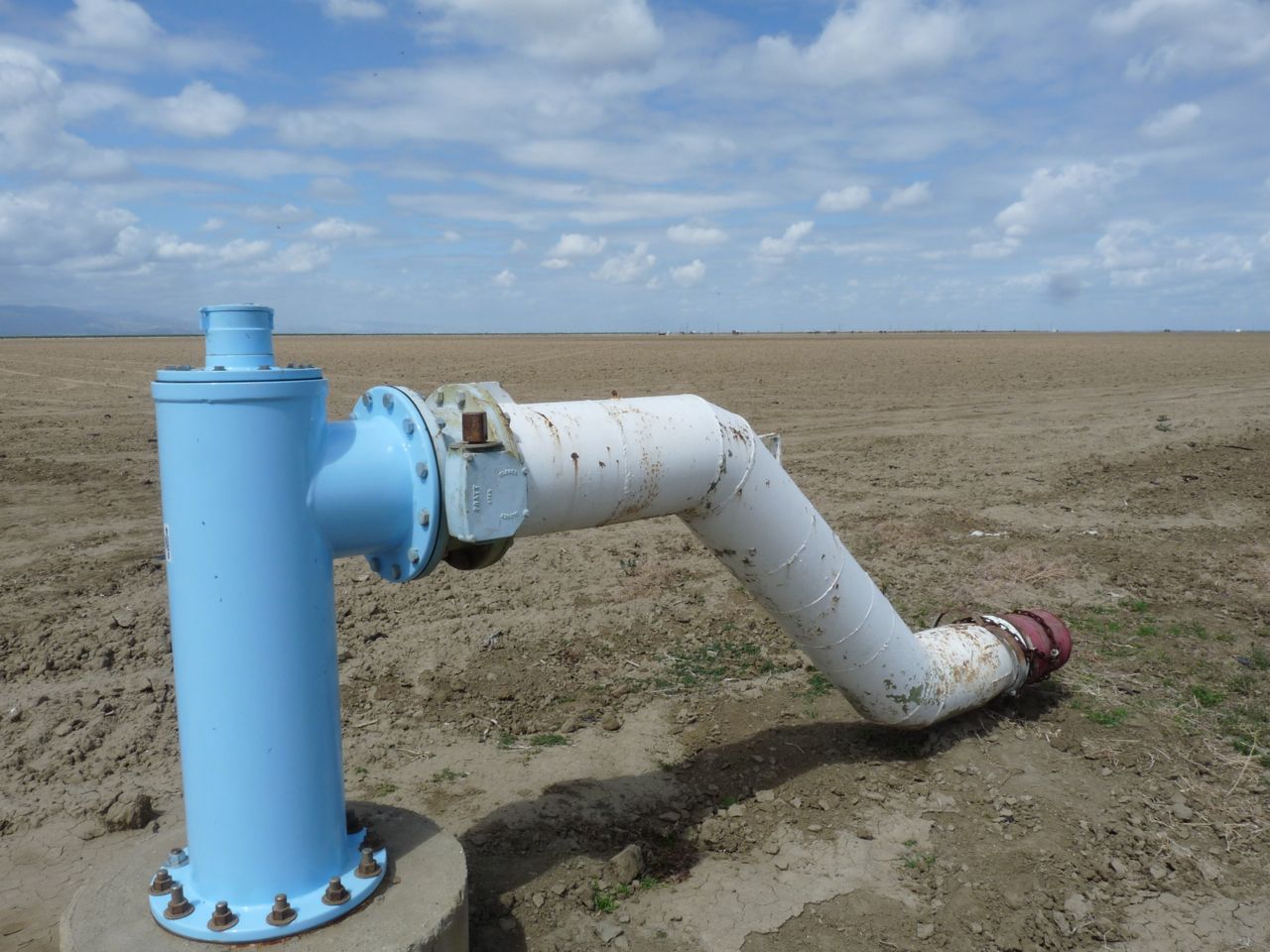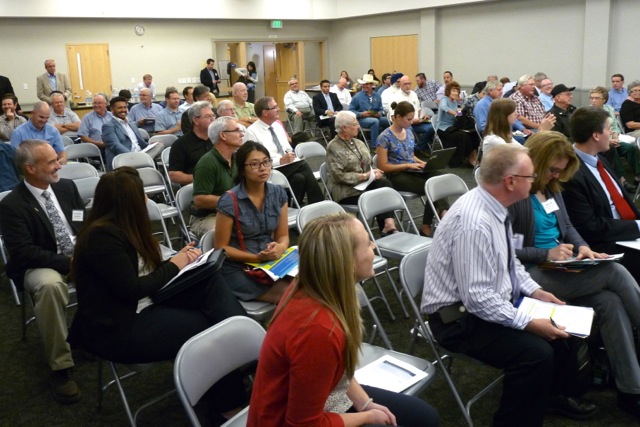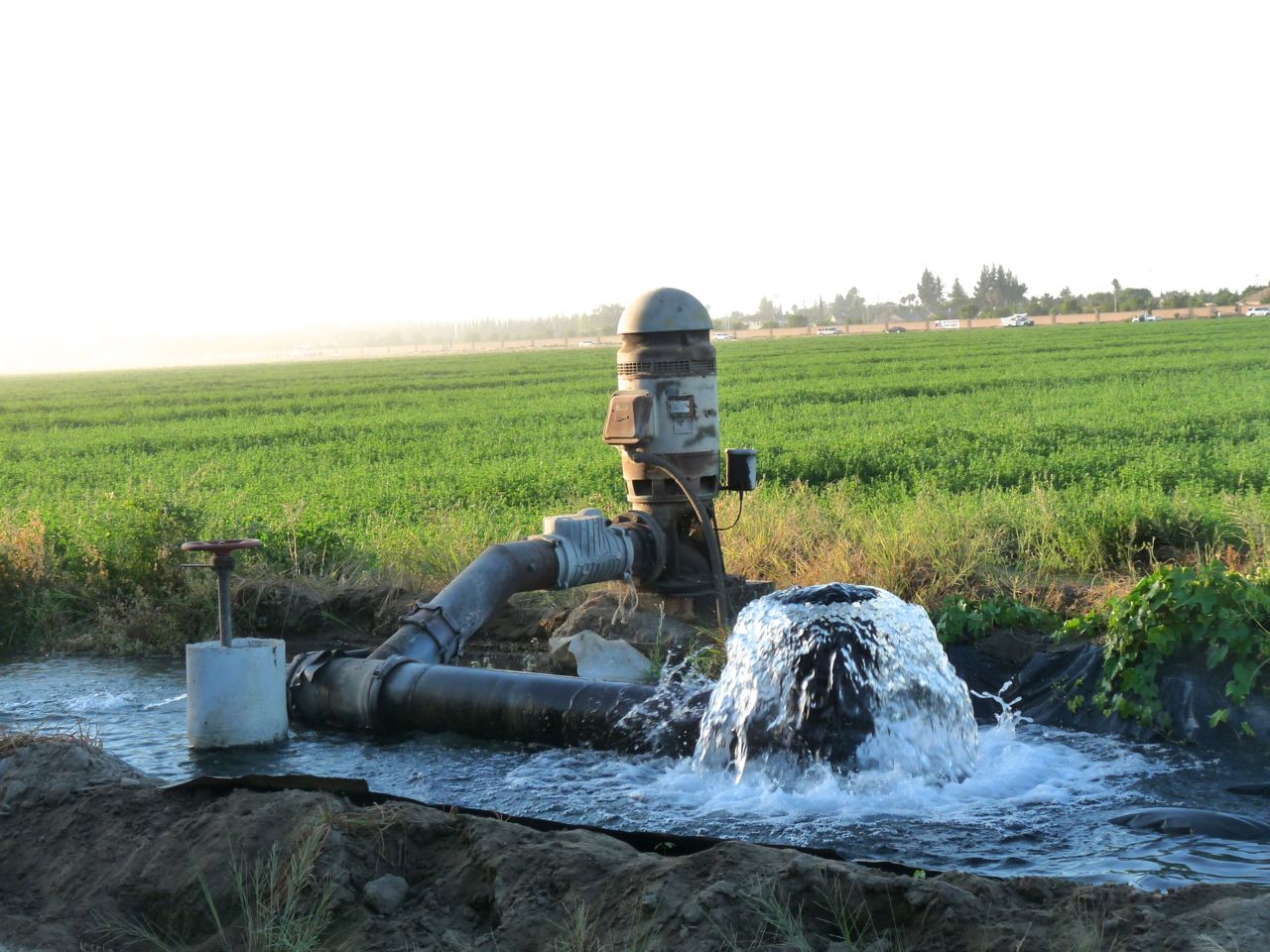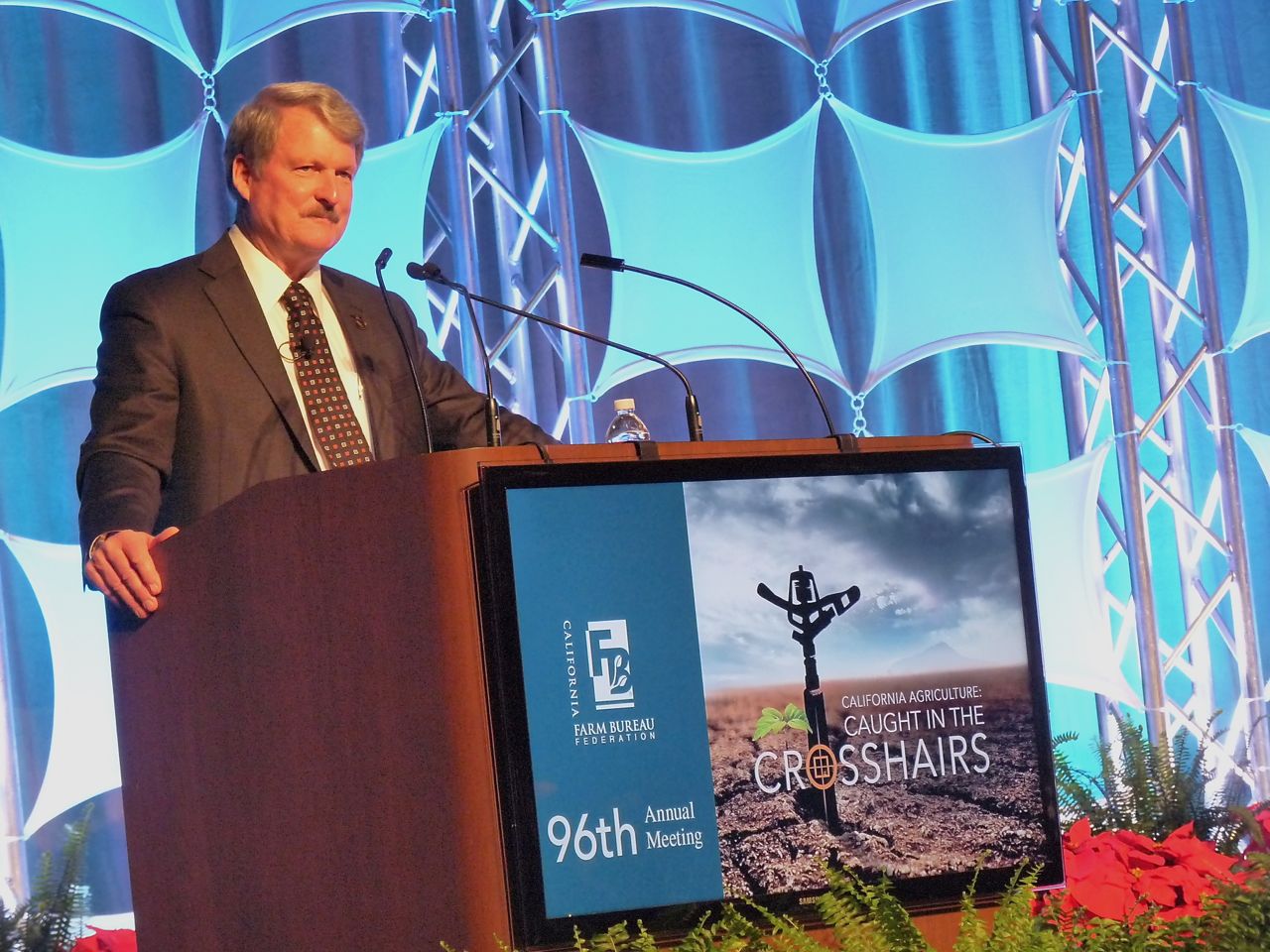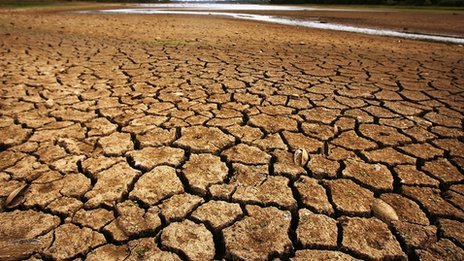California Water Ballot Initiative
California Water Ballot Initiative May Go to Voters in Nov. 2016
[embedvideo id=”O6sMsPaJPB4″ website=”youtube”]
Aubrey Bettencourt, executive director of the California Water Alliance (CalWA or “Alliance”), described the Alliance’s California water ballot initiative to California Ag Today’s farm news director, Patrick Cavanaugh. If passed by the voters, the measure, which rests in the hands of California Attorney General Kamala Harris to approve it for inclusion on the state’s November 2016 ballot, would strikingly change the water horizon for California. The initiative prioritizes all water to go to citizens of California and then to farms, before it reaches the environment. It combines $8 billion from the high-speed rail project funding with the $2.7 billon approved in November 2014 for water storage projects.
CalWA, a non-profit advocacy and education organization that is dedicated to raising awareness about the nature of water, advocates for the short- and long-term, sustainable policy and infrastructure positions that meet the need for safe, reliable and affordable water by the people, cities, businesses, farms and environment in California.

Aubrey Bettencourt, executive director of California Water Alliance
Cavanaugh: You have created a California water ballot initiative that, hopefully, will appear on the November 2016 ballot.
Bettencourt: Yes. It’s known as “California Water 4 All,” and it is really quite simple. After the Water Bond of 2014 passed, the California Water Commission—the fund administrators entrusted with the $2.7 billion allocated for water storage—placed other stipulations on that funding.
For instance, 50% of the water had to go to the environment and 50% had to directly benefit the Delta. Furthermore, the Commission would not release project funds prior to December 2016, so even though voters allocated funding and were promised water storage, construction was not to start for a long time. All these stipulations on the California Water Commission, through no fault of their own, actually challenged and limited the availability of regional water projects.
Then, when the Commission started to monitor both its funding and its responsibility over that funding—which we don’t blame them for, whatsoever—a lot of organizations that had opposed the Water Bond in 2014 for creating new water storage, suddenly started soliciting the Commission with letters saying, “You don’t have to define that water storage component as traditional water storage. You can open up that funding and grant it to anything else. You don’t have to use it for new water.”
We, as an organization, filed a number of letters in response and actually brought it to [the press], “Hey, they are trying to gut this tiny sliver of funding that was allocated in this program voted on by the people of California as a promise to create new water for us in this drought.” And also, “$2.7 billion would maybe build one and one half projects in California.”
We all know our water infrastructure is 60 years out-of-date, and it cannot keep it up with the needs of the environmental community, the government community, the agricultural community, and the urban community. You will hear everyone say that our infrastructure is so out-of-date that it can’t even keep up with the number of people we have or the amount of priorities we have set. Take a look at how various environmental projects end up competing against each other; a good example is when all of this came to light in the 2014 water bond fight.
Look at this year alone; there wasn’t enough water in storage and there wasn’t enough water available anywhere, so state policymakers had to decide between species. Which species were going to live? Which species were going to die? Why? ’Because there wasn’t enough water for all of them.
There are wetlands in Los Banos that never got water. The creatures and animals and species that are dependent on that habitat and viable property for their existence, did not get that opportunity. Why? ’Because an environmental project and species upstream took higher priority. There is not enough water to go around for all of the water users.
Cavanaugh: So what was the thought process behind combining the approved public funding of the high-speed rail project with the approved Water Bond funding?
Bettencourt: We are very connected to our community. We have always heard, “Well what if we could just change the priorities?” So we thought, “What if we could just take that money being used for high-speed rail and use it for water storage?”

Fallowed Field in Fresno County, California in 2014 due to zero water allocation.
Finally, our conversation with a number of our members and board transitioned to, “Well, what if? What would that look like?” Nobody had really looked into it. So our board decided to really invest into what that would look like. Could it be done? We were always told it couldn’t from a practical standpoint or even from a legal standpoint. We spent some time and resources looking into “What if” with some great legal minds in Sacramento.
We spoke with other organizations and people, especially those who had been involved in the rail and transportation side of this equation longer than we had—Citizens for High Speed Rail Accountability, most notably. We started pooling our resources into this inquiry, and sure enough, we found out it could be done.
Cavanaugh: And if the initiative were allowed on the ballot, it would be up to the voters to decide?
Bettencourt: Yes, it would. So, as we looked at it, we figured it was really quite remarkably elegant to reprioritize. And really, the theme of this ballot initiative is priorities. It is about getting our priorities in this state in the right order again and letting the public direct our elected officials with those decisions.
This ballot initiative takes the unissued bond funding from the high-speed rail project, which is about $8 billion, plus the $2.7 billion in water storage money from the 2014 Water Bond, and pools it in a new locked fund. The reason we did that is, quite frankly, “Why would we have two pots of money going toward the same thing?” It all needs to go into this new locked fund with the sole purpose of expanding the supply of new water for the state of California.
That fund can’t be borrowed against, pulled away from or pirated. The only way to change that funding would be to go back to the ballot and get the voters’ approval to move that funding around again.
An elected board would administer the locked fund.
Cavanaugh: ’Not the Water Commission?
Bettencourt: ’Not the Water Commission, nor appointed body at the state level, not even a legislative body. The board would be elected members from each of the water management districts. So, people from your community who have expertise and experience in water in their own region administer this fund that will benefit the entire state. Everybody gets a vote. You don’t have one region of the state having more of a vote than another region of the state; that is not what happens here. Everybody has a vote, and there is one at-large member that everyone in the state gets to vote on.
Cavanaugh: What about the Bay Area, and Los Angeles?
Bettencourt: ’Equal Players. Each of the regions has a representative on the board.
Cavanaugh: They only get one vote?

Central Valley Project (CVP) Water
Bettencourt: That’s right. So, in that structure, the funding is used fairly for the whole state. That is the long-term infrastructure portion of the proposed initiative.
We always talk about how the water crisis in California has two problems. One is an infrastructure problem, and, two: we have a management crisis. We don’t have set rules and regulations for where our water goes and how.
Cavanaugh: Can you elaborate?
Bettencourt: A good example is our own governor is saying he doesn’t have a plan for getting us out of this, and we don’t know what will happen when it starts raining. We don’t know how the system is supposed to be operated. There are no guidelines on the books anywhere right now. And in this time of drought, where you have low supply, you are seeing regulators making ad-hoc decisions. Well, there are no rules and there are no first, second, and last priorities. They are making decisions on a case-by-case basis, and that is no way to solve this.
We address the long-term shortage by expanding our water supply with more storage. Expanding the water supply for everyone increases the flexibility of our system, overall, for the environment, for agriculture, and for the communities of our state.
Cavanaugh: Is a constitutional amendment part of the initiative?
Bettencourt: The theme of this ballot is to get our priorities straight. We are taking what is already in the California Water Code that was passed in 1928. The people of California said, “This is the way we want our water used and in this priority,” and it was put in the California Water Code. Since then it has been subjectively adhered to.
But we take what was in the California Water Code—the intention of the people of California—put it into the State Constitution. And we say, “Reasonable and beneficial use of water is for people, food security, irrigation; and then everything else.” And we define what that is.
It is very simple. It is nothing new. It is already out there; but what is so important is that it addresses the immediate, and it instantly hands down the guidelines:
So, this is how we operate the system.
This is how we make these decisions.
These are the rules and orders of operation.
This is how we get ourselves out of the drought.
This is how we get our system back up and running. This is how you address the short-term: by setting the priorities, making them clear, providing guidelines to the regulators so they can do their jobs on behalf of the people of California to get us out of this drought and protect us from future droughts. From an operational standpoint, this provides the certainty we need in our water supply that we just don’t have. Also, when you expand supply for everybody, you gain back flexibility in the system.
Cavanaugh: That’s great, because as we know, the proposed Temperance Flat Reservoir can move water North or South and really help out if a seismic event were to occur in the Delta. How do we get around the Environmental Species Act (ESA) rules that affect the Delta?

Water in Friant-Kern Canal
Bettencourt: That is all federal, and this initiative does not address federal law. This is purely California-only. However, I think, should this measure pass, it would bump against the federal statute from an infrastructure standpoint because California pays for half the cost of an infrastructure project and from an operations standpoint as well. How would the federal regulatory system affect this California measure, should it pass? A new dialogue with the federal government would have to ensue after state voters adjust the priorities for our water supply.
Cavanaugh: So “California Water 4 All” is going to address water infrastructure. Of course, you can leave the whole ESA out of the conversation. So are building dams beyond Temperance, plus the Cross-Valley Canal the top priorities?
Bettencourt: Yes, we outline four specific projects within the infrastructure component of this initiative: Temperance Flat and Sites are the two darlings of the recent new water projects. In addition, we outline raising both Shasta and San Luis, which would minimally impact the environment and maximally impact water supply. The cost is low because while you are building on existing infrastructure and having less impact on the space you are taking up, you end up capturing more water utilizing existing footprints, which is great.
So we outline those four specific projects, which leaves almost $5.5 billion for additional regional water projects with the stipulation of creating new water. One good example is our partners in the Southland have a mandate from both the state and federal governments to capture and use storm runoff, but they don’t have the mechanisms to do that.
This ballot initiative could help them capture and store rain runoff in Southern California, which would provide more local regional water and increase flexibility to move water around the state north of them. So it is all about capturing more water and expanding supply, so we have more supply to go around.
Cavanaugh: It appears the best part of this initiative is that it benefits everyone in the state.
Bettencourt: Absolutely, and that was important to us when we crafted this initiative, that it couldn’t be so tight. This proposal really does benefit the entire state, not only from the macro-economic standpoint, such as new reservoirs; we are talking about groundwater recharge, storm water runoff, water recycling, desal, all of these projects would have a nice pot of money with the explicit direction of creating new water supply. And the best part about this entire initiative is it doesn’t cost anybody anything.
Cavanaugh: That must ring very nicely up there in Sacramento.
Bettencourt: It does. There is no new burden on the taxpayers; these are dollars that already been approved of by the voters. The only thing we are doing is reprioritizing. It is no different than if you are at home considering, “Well, I’d really like that new pair of shoes, but I have a leaky toilet I must fix. I’m going to take that money and say, “The shoes are great. I love the shoes. They get me to where I want to go, but the toilet is kind of mandatory right now. It is the only one in the house and that’s that priority.”
We have only one water supply, and transportation is absolutely important…
Cavanaugh: You are talking about the health and safety of the state—not just drinking water—but health and safety.
Bettencourt: The health and safety of our state and its environment are absolutely important. We were talking about this as a team, and someone on the team said, “This is about survival. In order to survive, you need to know what your need and use priorities are.”
California voters have made priorities of water need and use very clear, and it is time that we put that first so we can afford everything else. This is a great state and our organization always advocates from the position of, “We should be able to BE the Golden State and grow and revolutionize going forward over the next century. And that will happen if we get up to speed and have our priorities straight to meet and provide the most basic needs of the innovators and doers of California.

Lettuce Harvest in Fresno County
So we have written the initiative; that was a heavy lift. Then we found two great proponents in California State Senator George Runner, Vice Chair of the Board of Equalization, and California State Senator Bob Huff to act as our submitting proponents. We, at CalWA, are the sponsoring organization, and we have submitted the package to Attorney General Harris.
Now the Attorney General has 50 days from November 13, 2015 to say, “Yes this can go on the ballot,” and to return it with a suggested title and ballot summary or how it will appear on the ballot to be read by the voter.
We have also held required meetings with the Legislative Analyst’s Office, which score the ballot measure’s costs to the taxpayer. The costs will be budget neutral because there are no new funds. So, after 50 days, we will know whether or not we will be permitted to qualify for the ballot. We are hoping we will be, at which point we would have until April 16 to get 900,000 signatures of California voters to qualify automatically.
Cavanaugh: April 16 is not a lot of time before the election.
Bettencourt: That’s right. So everyone with a ballot initiative has to follow these rules: 50 days then hit the streets and get the signatures. This is the campaign mode so voters can make this decision in November 2016.
Cavanaugh: Do you anticipate any lobbying from Attorney General Kamala Harris’s office?
Bettencourt: No, It’s strictly in Kamala Harris’s hands on this one. We are permitted to suggest our own title and summary, but the decision will come from her office. I think over 100 ballot initiatives have been submitted.
Our biggest concern is that someone will say there are too many initiatives. Secondly, how do we stand out among so many other ballot initiatives?
Cavanaugh: How do we ensure this initiative stands out? It is going to be competing for attention in a presidential election year, as well as a big election year in the state, so it is no easy undertaking.
Bettencourt: The feedback we are getting is voters want to make this decision. They want to say, “Yep, we are changing priorities, not that we think certain projects are not important. We believe certain projects are more important than others at a given point in time.”
Cavanaugh: Doesn’t it seem like the best time to do it? A poll of California citizens shows they are concerned. The top priority, behind jobs, is water availability.
Bettencourt: Yes, the Public Policy Institute of California’s polls over the last year support that. And I think the Hoover Institute conducted an independent survey of California voters at the beginning of last year, ranking the top 36 priorities of the state: number 36 was high-speed rail and number 2 was water. So the California public is stating, “This is our priority now.” We want to make sure we give the voters of California an official opportunity to say that.
Cavanaugh: While we wait for the Attorney General’s approval or disapproval, where can we get more information on California Water 4 All?
Bettencourt: Visit our website: CAWater4All.com. There you will find the language of the ballot initiative. You’ll be able to read the legalese, first-hand. It is about 25 pages—could be worse; could be better.
We worked really hard to make that tight. You’ll also find summaries of the initiative, how it benefits the environment, what the facts are on high-speed rail and why all of a sudden we think high-speed rail needs to be a different priority at this point. What are the facts on water supply and where are we on our storage? Where are we regarding the competing mandates on our existing supply? Why are changes in direction and priority needed? We must create certainty in our water supply so we can get out of this drought and we need to know how to handle the next one when it comes.
Cavanaugh: Comment on your outreach for people to connect with you on the website to increase voter awareness of what’s going on.
Bettencourt: We are setting up this campaign to be as interactive with constituents as possible. Right now during the 50-day period, there is not much to do besides staying connected with us. We’ll be communicating on a weekly basis, if not more often. We’ll share not only what are other people saying about the initiative, but also where we are in the process: when it is time to sign up, to volunteer and to help us gather these signatures and where to get them.
If you visit the website, CAWater4all.com, you’ll can register with your email, your cell phone if you choose, and your zip code so we know your location in the state. You’ll be able to stay connected with us on next steps in the process and be active with us as well. There is also a donation page. This ambitious endeavor is going to take time, treasure and talent, so we need all the help we can get.
Cavanaugh: Once on the ballot, what do you envision initiative cost will be?
Bettencourt: The rule of thumb for an average statewide campaign in California when we took this on was $10 million, and that is the operating budget we are thinking about here. So, this is going to take little donations and big donations. But more importantly, this is going to take spreading the word, so we really encourage people to get connected.
Cavanaugh: Other social media?
Bettencourt: All social media: @cawater4all on on Twitter and cawater4all on Facebook as well.

The Water Priorities Constitutional Amendment and Bond Act (Source: California Water 4 All, CalWA)

